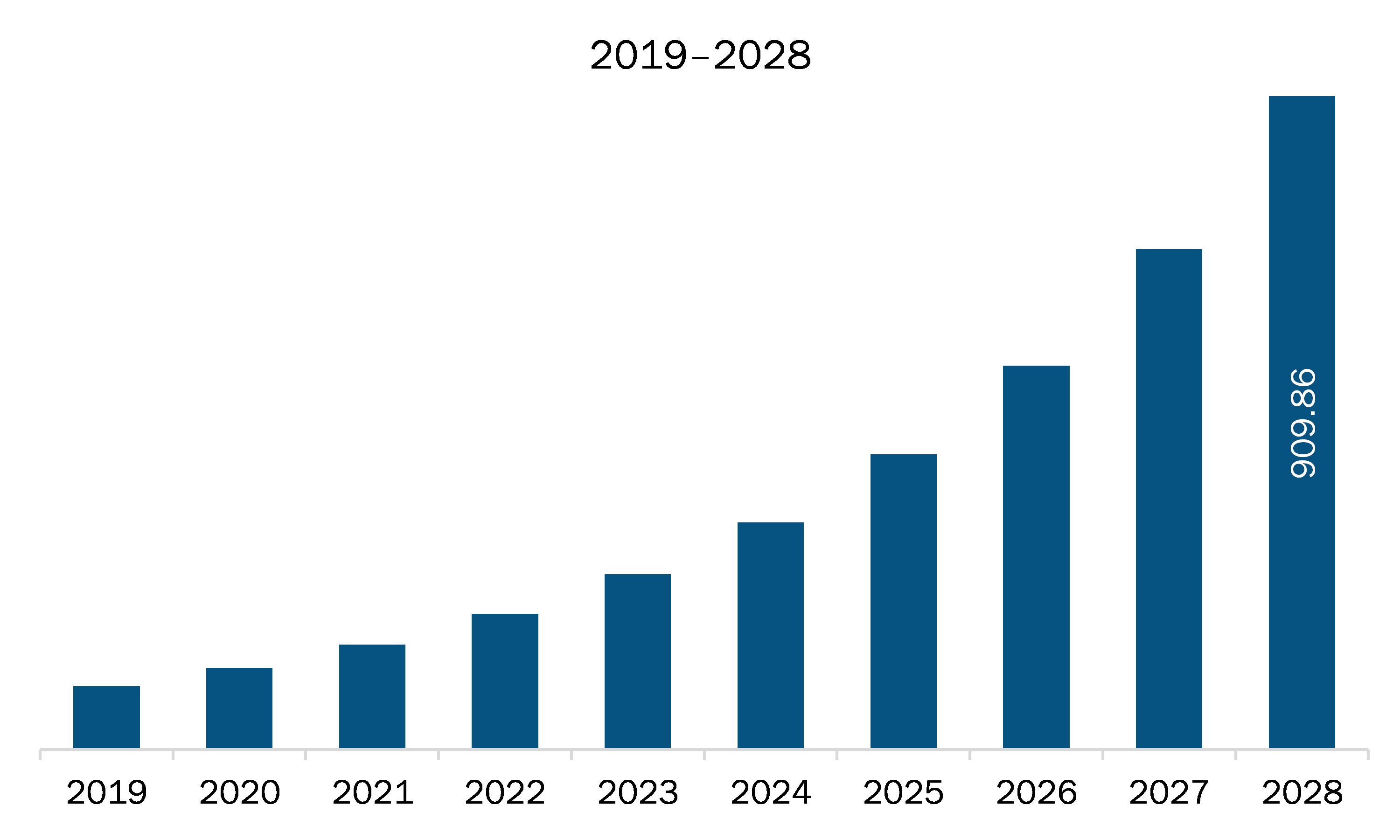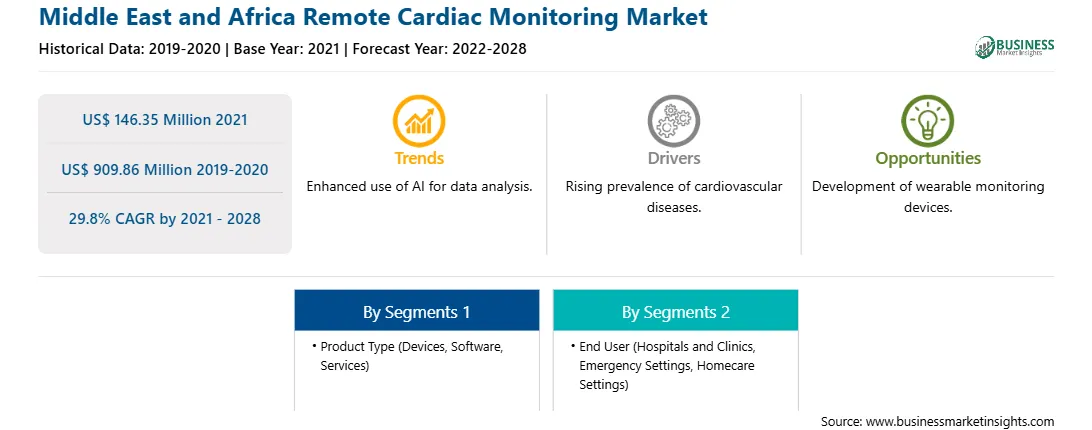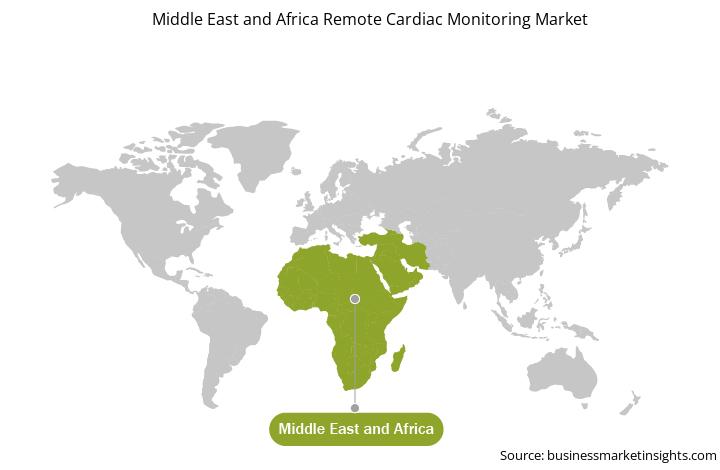Prime markets for remote cardiac monitoring in Middle East & Africa are United Arab Emirates (UAE), Saudi Arabia and South Africa. The market is driven by the factors such as the rising burden of cardiac diseases and the need to control mortality rate with early diagnosis, and treatment for these diseases. In most of the cardiac disorders, continuous cardiac monitoring is required. Increasing government initiatives, growing number of research and development activities, and increasing number of product launches and approvals in the region are also some of the reasons towards the growth of the market. Saudi Arabia is one of the fastest-growing regions in the Middle East and Africa, driven by a huge population and increasing adoption of medical devices. As a part of their Vision 2030 initiative, the government of Saudi Arabia launched a National Transformation Program in 2016. The government had launched this program for the overall development of Saudi Arabia across all industries. In addition, this program is linked to the implementation of primary and digital infrastructure projects in several industries. Under this program, the government focuses on consolidating and transforming the health system by improving access to health services, improving health efficiency and quality, and preventing chronic diseases. This government-approved strategic policy creates lucrative medical device commercialization opportunities that will ultimately fuel the growth of the remote heart monitor market in Saudi Arabia over the forecast period. Increased awareness of health issues and increased consumption of health services are contributing to a significant market for medical devices. With the National Transformation Program 2020, the Saudi Arabian government is trying to radically change the structure and function of its health system in order to achieve high-quality care and effective service provision. According to Globalization and Health, several studies from Saudi Arabia have found that some people needed long-term medical care e.g., heart diseases may have compromised access to quality health care due to long waiting lists, high burden of hospital-acquired infections due to long-term hospitalizations, and high rate of medical errors at the hospitals. Recent developments in connected health technology provide the opportunity to remotely monitor and provide health care to patients in need of long-term medical care. Remote cardiac monitoring services are performed as recommended by the referring physician. Prior to each examination, medical personnel takes a detailed cardiac history and maintains a reference of the patient’s ECG test. This enables the alarm thresholds to be individually adjusted, which triggers an automatic monitoring reaction for each patient.
The COVID-19 pandemic has increased the demand for medical devices, which can be used in-home care. The region is witnessing an increase in the number of patients admitted to intensive care units (ICU). An increasing number of drugs pose multiple diagnostic and therapeutic challenges to strained health systems, leading to an increase in medical devices. Radiologists in South Africa have the highest number of COVID-19 infections in the country. There are changes in staff assignments, working hours, strict infection control, and social distancing measures. They also face mental, physical, emotional, and financial challenges.

Strategic insights for the Middle East and Africa Remote Cardiac Monitoring provides data-driven analysis of the industry landscape, including current trends, key players, and regional nuances. These insights offer actionable recommendations, enabling readers to differentiate themselves from competitors by identifying untapped segments or developing unique value propositions. Leveraging data analytics, these insights help industry players anticipate the market shifts, whether investors, manufacturers, or other stakeholders. A future-oriented perspective is essential, helping stakeholders anticipate market shifts and position themselves for long-term success in this dynamic region. Ultimately, effective strategic insights empower readers to make informed decisions that drive profitability and achieve their business objectives within the market.

| Report Attribute | Details |
|---|---|
| Market size in 2021 | US$ 146.35 Million |
| Market Size by 2028 | US$ 909.86 Million |
| CAGR (2021 - 2028) | 29.8% |
| Historical Data | 2019-2020 |
| Forecast period | 2022-2028 |
| Segments Covered |
By Product Type
|
| Regions and Countries Covered | Middle East and Africa
|
| Market leaders and key company profiles |
|
The geographic scope of the Middle East and Africa Remote Cardiac Monitoring refers to the specific areas in which a business operates and competes. Understanding local distinctions, such as diverse consumer preferences (e.g., demand for specific plug types or battery backup durations), varying economic conditions, and regulatory environments, is crucial for tailoring strategies to specific markets. Businesses can expand their reach by identifying underserved areas or adapting their offerings to meet local demands. A clear market focus allows for more effective resource allocation, targeted marketing campaigns, and better positioning against local competitors, ultimately driving growth in those targeted areas.

The remote cardiac monitoring market in MEA is expected to grow from US$ 146.35 million in 2021 to US$ 909.86 million by 2028; it is estimated to grow at a CAGR of 29.8% from 2021 to 2028. Surge in preference for remote patient monitoring during COVID-19 pandemic; new era of cardiac management began in 1960 with the creation of the first implantable pacemaker, which has since saved countless lives and transformed the practice of medicine. Furthermore, the implementation of remote patient monitoring (RPM) was a pivotal step in this advancement. In the aftermath of COVID-19, remote monitoring has emerged as a promising solution. Amid the COVID-19 pandemic, compelling people to avoid crowds and going out at public places, healthcare providers are emphasizing providing patient-centered care through virtual medical treatments. Elderly populations suffering chronic diseases, among other people, require frequent check-ups and continuous health monitoring. It is time-consuming for them to drive back and forth to visit physicians, and alternatives such as in-house care are unreasonably expensive for the majority of them. Moreover, they can be at a high risk of COVID-19 infection during hospital visits. These factors have led to the increased adoption of remote patient monitoring. With the rise in the use of remote patient monitoring during the COVID-19 pandemic, many companies have redirected their focus on mergers and acquisitions. Philips has recently agreed to acquire BioTelemetry, a medical technology company that specializes in cardiac diagnostics and remote patient monitoring services. This deal would allow Philips to expand its remote patient monitoring business beyond hospitals and into patients' homes. Philips is already a major player providing remote patient monitoring devices for the hospitals segment. As telemedicine is becoming an integral part of various national healthcare strategies to combat COVID-19, the demand for remote patient monitoring devices that are interoperable with the service provider's telehealth infrastructure is bound to rise. This is bolstering the growth of the remote cardiac monitoring market.
Based on product type, the market is segmented into devices, software, and services. In 2021, the devices segment held the largest share MEA remote cardiac monitoring market. Based on devices the market is divided into vital signs monitors, heart rate monitors, blood pressure monitors, breath monitors, holter monitors, and others. Vital signs monitors is expected to the fastest growing segment over the forecast period. Based on software the market is divided into cloud based software and on-premise software. The cloud based software segment accounts for largest market share in the 2021. Similarly, based on end user, the market is segmented into hospitals and clinics, emergency settings, homecare settings and others. In 2021, the hospitals and clinics segment held the largest share of the market.
A few major primary and secondary sources referred to for preparing this report on the remote cardiac monitoring market in MEA are company websites, annual reports, financial reports, national government documents, and statistical database, among others. Major companies listed in the report are Abbott; Boston Scientific Corporation; GE Healthcare; Honeywell International Inc.; Koninklijke Philips N.V.; Medtronic; Nihon Kohden Corporation; and OSI Systems, Inc. among others.
The Middle East and Africa Remote Cardiac Monitoring Market is valued at US$ 146.35 Million in 2021, it is projected to reach US$ 909.86 Million by 2028.
As per our report Middle East and Africa Remote Cardiac Monitoring Market, the market size is valued at US$ 146.35 Million in 2021, projecting it to reach US$ 909.86 Million by 2028. This translates to a CAGR of approximately 29.8% during the forecast period.
The Middle East and Africa Remote Cardiac Monitoring Market report typically cover these key segments-
The historic period, base year, and forecast period can vary slightly depending on the specific market research report. However, for the Middle East and Africa Remote Cardiac Monitoring Market report:
The Middle East and Africa Remote Cardiac Monitoring Market is populated by several key players, each contributing to its growth and innovation. Some of the major players include:
The Middle East and Africa Remote Cardiac Monitoring Market report is valuable for diverse stakeholders, including:
Essentially, anyone involved in or considering involvement in the Middle East and Africa Remote Cardiac Monitoring Market value chain can benefit from the information contained in a comprehensive market report.